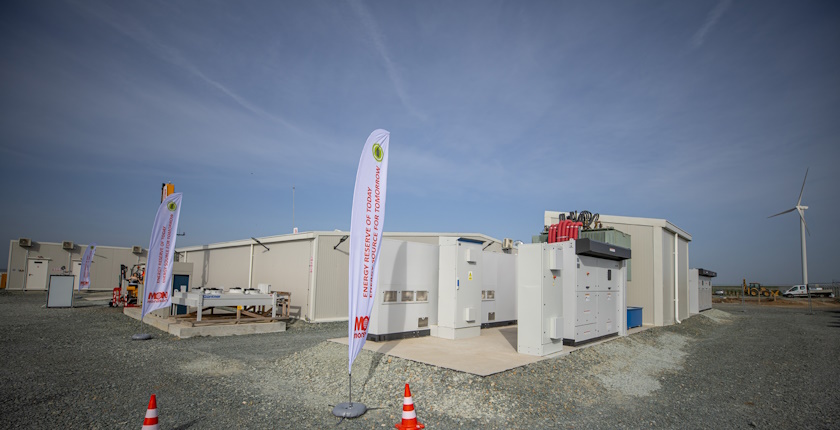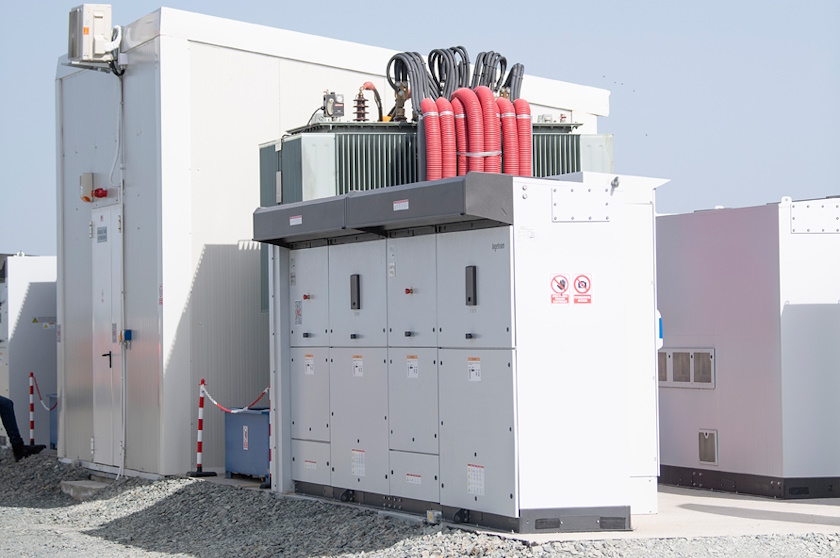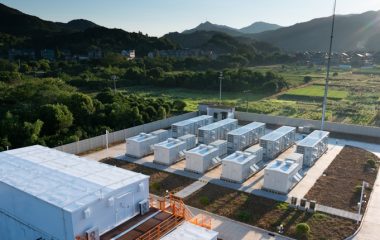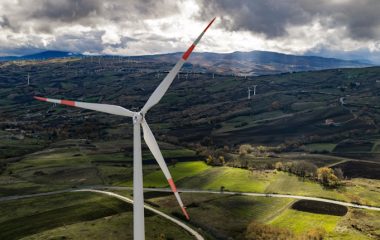
Photo: Monsson
Monsson inaugurated a 24 MWh battery energy storage system in Romania. It is the first phase out of 216 MWh planned in total. The facility is connected to the company’s Mireasa wind farm of 50 MW, while a 35 MW solar power plant is set to be added by the end of the year.
Hybrid power plant projects for more than one renewable source and energy storage are still rare in Europe. Still, it may not take long before they become standard. In partnership with Prime Batteries Technology in Romania, Monsson completed a major step in combining a wind and solar power investment with batteries.
The company officially put into operation an energy storage system. Located in Constanța county in Romania, the facility has 6 MW in operating power and a capacity of four hours, It translates to 24 MWh, making it the biggest battery energy storage system or BESS in the country.
Moreover, it was just the first of three phases that are envisaged to be completed at 216 MWh by next year. There is still no battery of such size in Europe. Early-stage investor in battery producers EIT InnoEnergy participates in the project.
Backed by the European Union’s European Institute of Innovation and Technology (EIT), it is a shareholder in Romania-based Prime Batteries Technology or PBT, which manufactured the modular lithium ion BESS.
Monsson built energy storage unit at location of Mireasa wind farm
The unit in the Dobruja (Dobrogea) area is part of a pioneering hybrid power plant investment. It will be integrated with wind and solar power, which are mostly complementary. Namely, photovoltaics are operational only in daylight and have the strongest output in the summer, while the wind is usually stronger at night and in the winter.
The Gălbiori 2 solar park is expected to be added to the hybrid power plant in Dobruja by the end of the year
Monsson’s new BESS will store excess electricity from wind turbines and solar panels, to be used at times when domestic demand is stronger. The unit will be charged with energy from the existing 50 MW Mireasa wind farm at the same location, the developer reiterated. It said it is building the 35 MW Gălbiori 2 PV farm at the site. The unit is scheduled to be connected to the grid before the end of the year and added to the equation.
The existing Gălbiori solar power plant has just above 1 MW in connection capacity.

BESS can draw electricity from grid when there is no wind, sunshine
When there is no wind or sun, energy from the national grid can also charge the BESS, EIT InnoEnergy pointed out. All operations are automated and remotely controlled.
The unit functions within an integrated system via software crafted by Monsson. Its solution includes electricity trading features. The company said its energy storage is being developed to withstand harsh climate conditions.
The battery facility at the Mireasa wind farm is among the largest five in Europe, according to Prime Batteries’ CEO Vicentiu Ciobanu
Hybridization with storage reduces renewables’ volatility and helps balance the national energy system. “With this project we are testing the functionality of the battery to demonstrate the immediate benefits of storage facilities attached to renewable energy sources. We want to promote such solutions both in Romania and across Europe,” Monsson’s board member Sebastian Enache said.
The first stage of the battery unit has 132 battery strings with a total of 114,048 lithium ion cells containing 1,240 kilometres of active material electrodes, PBT’s Chief Executive Officer Vicentiu Ciobanu revealed. “At the moment, our project is among Europe’s five largest,” he stressed.
ANRE’s Andronache: Storage is energy consumption as well as production
Monsson was established in 1997 and its focus is on renewables since 2004. The developer has 5 GW of wind and solar power projects in the pipeline in Romania. It provides turnkey services for designing, developing, constructing and operating renewable energy and storage projects.
Prime Batteries Technology has a lithium ion battery production capacity, including battery cells, of 2.3 GWh per year in Bucharest. Last year it manufactured more 65 MWh for the Romanian market, mostly in renewable energy applications. The company said it has experience from venture projects in the United Kingdom, Germany, Norway, Spain, Italy, Poland, Croatia, Slovenia, and Turkey.
“Storage is both energy consumption and energy production and should be treated and regulated as such and, why not, prioritised,” Vice-President of Romanian Energy Regulatory Authority (ANRE) Gabriel Andronache said at the inauguration.
Transelectrica: Romania must attract consumers
During sunny days, at noon, when photovoltaics have maximum production, the price of electricity is zero, said Virgiliu Ivan, head of national grid dispatch in Romania’s transmission system operator Transelectrica. He highlighted the role of storage solutions.
“In the past years we have all made efforts to increase renewable electricity production in Romania, and we all need to join forces to attract also consumers. In Dobrogea region, for example, we have an installed capacity of 3,280 MW, while electricity demand is only 300 MW, Ivan noted.
Of note, Monsson is participating with Rezolv in the Dama Solar project of 1.06 GW in Arad, near the border with Hungary. It would currently be the biggest photovoltaic system in Europe.









Be the first one to comment on this article.